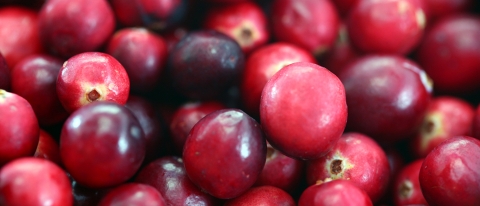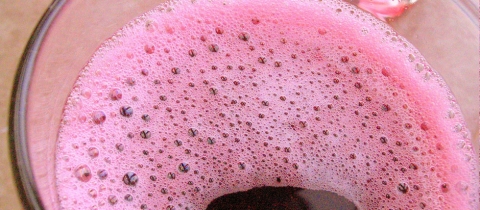When I was young, the first official day of summer for me was not June 21st. It didn’t matter what the weather was, summer did not really begin until the day my mother made cold sour cherry soup from the first freshly picked tart cherries of the season. What a delight that was! I wolfed down bowlfuls because it tasted so good. I didn’t even dream that it might actually be good for me!
OK, OK. I can see your collective eyebrows being raised out there. Here comes some more unwelcome dietary advice about what we should be eating. You’re probably sick of it. Depending on the week and the research findings that have made it into the news, you’ve been urged to consume more tomatoes, broccoli sprouts, Brazil nuts, margarine, soy milk, apple cider vinegar, oats, flaxseed, emu meat, kiwi, red wine, cheese, tofu or more of some herbal extract that nobody ever heard of. The advice is usually accompanied by reference to some “breakthrough” research by a “leading” scientist and triggers a new-fangled feeding frenzy, at least for a few days. Then some other equally eminent spoilsport authority will begin to blast holes into the research and explain that the findings may apply to rats raised on laboratory chow or to humans who subsist totally on baloney sandwiches but cannot be extrapolated to the public at large. So people go back to eating the way they were eating before.
Too bad. Because in that cacophony of scientific and pseudoscientific prattle there are some nutritional gems. They just have to be scooped out by scrutinizing the underlying science. The benefits of soy and broccoli, for example, seem well established. But they are not miracle foods. They have to be evaluated in the context of the overall diet. So I’m certainly not going to get into the good food-bad food game and start suggesting that people load up on certain foods and eliminate others. As, the saying goes, there are no good foods or bad foods; there are only good diets and bad diets.
That being said though, we have to recognize that diets are in fact composed of individual foods and that there are foods that should be featured more prominently than others. Perhaps the best established nutritional advice is that we ensure ample consumption of fruits and vegetables. That’s because they are filled with various “phytochemicals” (just a scientific way of saying chemicals derived from plants) which in numerous studies have been linked with disease prevention. Scientists estimate that perhaps 20% of cancers could be prevented if we just consumed five to ten servings of fruits and vegetables daily. Of course, we would really love to know which specific chemicals are responsible and where they are most likely to be found. Then we could make wiser choices about which fruits or vegetables to feature in the diet and perhaps even incorporate certain phtyochemicals into dietary supplements.
Now back to my cherries. They have been extensively studied, particularly the tart varieties. Much of the work has been carried out by Dr. Muralee Nair and his group at Michigan State University, undoubtedly prompted by the fact that the State of Michigan produces about 75% of the US crop. Obviously any positive findings about cherry eating are most welcome in Michigan. And there certainly have been some. The focus of fruit research these days is on compounds referred to as antioxidants. Researchers widely believe that a major part of the benefits attributed to consuming fruits and vegetables can be traced to the presence of antioxidants which can neutralize the effects of free radicals. These highly reactive substances are a byproduct of normal metabolism and have been linked with conditions ranging from cancer and arthritis to ageing. They also play a role in triggering the spoilage of foods, particularly those with a high polyunsaturated fat content.
Anthocyanins, pigments found in many plant products, are very effective antioxidants. Indeed, when isolated, they perform comparably to BHT, a commonly used food preservative. This observation prompted Michigan State scientists to investigate whether the addition of sour cherries to hamburger meat could reduce the rate at which fat was oxidized. Oxidation of fat in foods may have adverse health consequences and is a major contributor to off-flavor. The cherries did the job! In fact they did more! One of the concerns about heating meat is the formation of heterocyclic aromatic amines (HAAs), compounds which are carcinogenic in rodents and primates and probably in humans. When cherries were mixed with hamburger meat to the extent of about 12% by weight, the formation of HAAs was reduced by a staggering 70-80%. Whether this is due to the anthocyanins or to some other compounds that occur naturally in cherries has not yet been established.
A Michigan cherry grower who also happens to be a butcher (how often do you find that combination?) has already capitalized on the idea. He convinced the US Department of Agriculture’s National School Lunch Program to feature cherry burgers and these unique delicacies are already on the menu in 16 states. They are low in fat and high in antioxidants! Apparently they taste great to boot.
The research on the antioxidant properties of sour cherries had another salubrious outcome. The isolated antioxidants, particularly one called cyanidin, had an unexpected antiinflammatory effect. Inflammation is commonly caused by compounds in the “prostaglandin” family which are formed in the body through the work of enzymes called cyclooxygenases. Aspirin, for one, inhibits these enzymes and is therefore referred to as a prostaglandin inhibitor. It’s antiinflammatory effects are of course well established. It seems that cherry extract is an even more potent prostaglandin inhibitor, perhaps by as much as a factor of ten. In a preliminary study, 20 sour cherries provided and alternative to a standard dose of aspirin for the treatment of arthritis. Unfortunately sour cherries are seasonal and not commonly available. Sour cherry juice, on the other hand, can be found. Whether it is as effective or not has not been studied. But hey, it sure tastes good. So what’s to lose? I haven’t seen any cherry-extract pills yet in the health food stores, but I’m sure some enterprising merchants are already working on putting the cart before the horse.
If you would like a little more tantalizing cherry information, here it is. Quite aside from the antioxidants, cherries contain another substance with interesting properties. Perillyl alcohol has been shown to have antitumor effects in laboratory animals and has also been shown to have cancer preventative properties. Preliminary human trials have not shown any significant effect in terms of treatment but perillyl alcohol does hold promise as a model for a new class of antitumor agents.
So life may really be a bowl of cherries. And it seems it is the sour cherries that may have the sweetest effect. I’m not advocating these as a cure-all, but why not add them to the increasing arsenal of fruits that have disease fighting properties? Just don’t eat the seeds. They contain cyanide. Certainly not enough to do any harm, but spit them out anyway. As far as you can. With a little practice you may even have a go at the International Cherry Pit Spit Competition held every year in Eau Claire, Michigan. Actually, bringing home the trophy may require more than a little practice. It may require some elaborate body, neck and mouth coordination. According to the Guiness Book of Records, the distance to beat is 22 meters! So practice away! It may take some training, but at least with eating all those cherries, you won’t have to worry about muscle inflammation. Then if all the exercise makes you hungry go out and have a cherry burger. And wash it down with cherry juice.






